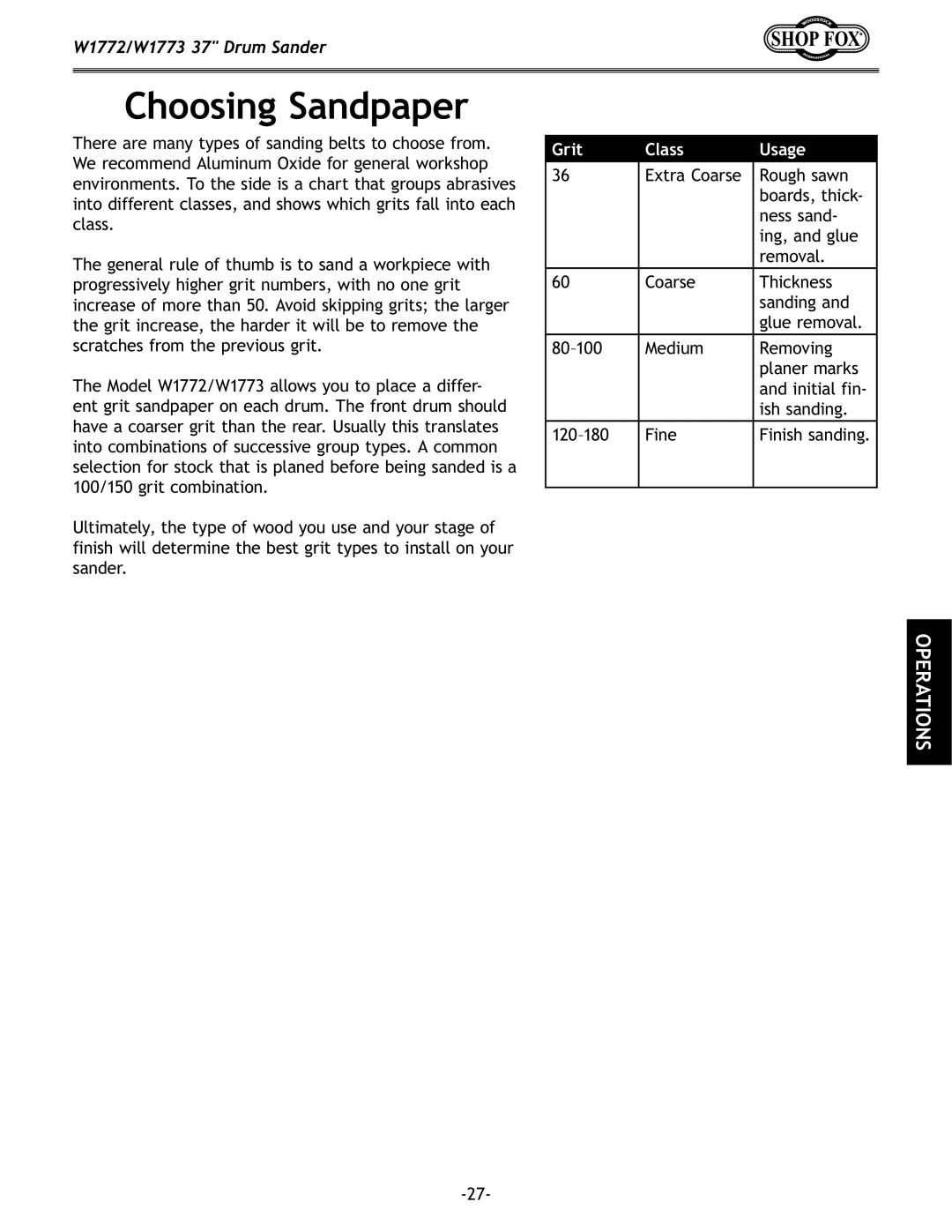Drum Sander
Page
Contents
Woodstock Technical Support
Introduction
Introduction
Introduction
Introduction
Introduction
Controls and Features
Standard Safety Instructions
Safety
Always Lock Mobile Bases if Used Before Operating Machinery
Additional Safety for Drum Sanders
Electrical
W1772 Single-Phase Operation
W1772 Electrical Specifications
W1773 Electrical Specifications
W1773 220V/440V Phase Operation
Phase Converter
To rewire the Model W1773 for 440V operation, do these steps
Rewiring W1773 to
Items Needed for Setup
Setup
Unpacking
Inventory
If you do not hear any scraping sounds go to Step
Assembly
Control panel mounting bolts
W1772/W1773 minimum working clearances
Machine Placement
To place the sander in a permanent location, do these steps
Lifting Sander
Mounting to Shop Floor
To connect the sander to the power source, do these steps
Power Connection
Dust Collection
Recommended CFM at Sander
To check the gear oil, do these steps
Gear Oil Check
To test run the drum sander, do these steps
Test Run
SET
Recommended Adjustments
Control Panel
Operations
General
Sanding Drums Start Button Starts the sanding drums
Depth of Cut
To adjust the conveyor speed, do these steps
Variable Speed
To set the depth of cut, do these steps
To sand a workpiece, do these steps
Using the Amp Draw Meter
Sanding
Sanding Tips
Grit Class
Choosing Sandpaper
To change the paper, do these steps
Paper Replacement
Drum Sander Accessories
Lubrication
Maintenance
Cleaning
Lubricating gear box
Step
To make the gauge blocks, do these steps
Service
Gauge Blocks
To adjust V-belt tension, do these steps
Belt Service
To align the pulleys, do these steps
Bearing Replacement
Pages 38
That no obstructions prevent bearing lubrication
To tension the conveyor, do these steps
Conveyor Tensioning Tracking
To track the conveyor, do these steps
Tracking
Adjusting Drums Perpendicular to Feed Direction
Drum Adjustments
Loosen the front drum pillow bearing lock nuts Figure
Front and rear drum Adjustment locations
Adjusting Drum Height & Drum-to-Conveyor Parallelism
Loosen the front drum pillow bearing lock nuts ,
Rear right sanding drum micro Adjusting knob
Pressure Roller Height
Pressure roller adjustment Nuts
Scale Pointer Calibration
To adjust a dust scoop, do these steps
Dust Scoops
Table Lift Scews
Marking sprocket tooth Chain
To adjust the table lift screws, do these steps
Emergency stop bar limit Switch
W1772/W1773 Wiring Overview
W1772/W1773 Control Panel
W1772/W1773 control panel wiring
W1772 electrical box
W1772 Electrical Box 220V, 1-Ph
Figures
W1772 Electrical Box Wiring 220V, 1-Ph
W1772 Sanding & Feed Motors
W1772 sanding drum motor Wiring and start capacitors
W1773 Electrical Box 220V, 3-Phase
Figures
W1773 Electrical Box Wiring 220V, 3-Phase
W1773 440V 3-phase electrical box wiring
W1773 Electrical Box 440V, 3-Phase
Figures 66
W1773 Electrical Box Wiring 440V, 3-Phase
W1773 Sanding Drum Motor
W1773 220V sanding drum motor Wiring
W1773 Feed Motor
W1773 220V feed motor wiring
Moving parts have come to a complete stop
Troubleshooting
Machine Operations
Frame Parts Breakdown
Parts
PART# Description
Frame Parts List
Parts Breakdown
Conveyor Parts List
XPK55M
Roller & Drum Parts Breakdown
Micro-Adjustment Breakdown
Electrical Components
Currentsensor
Electrical Parts List
Label Placement
Comments
Warranty Registration
BOX BELLINGHAM, WA
Warranty

